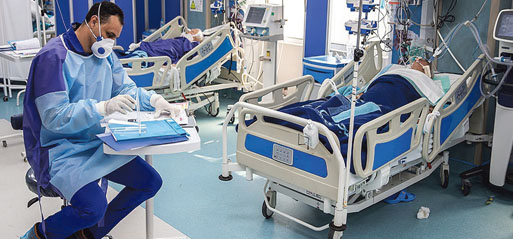
(Photo credit: Mohsen Atayi/WikiCommons)
According to figures from the Office for National Statistics (ONS), there were over 650,000 deaths registered in the UK in 2022, which is 9 per cent higher than in 2019 (the year before COVID), with over 35,000 additional deaths recorded in the last six months, which is 11 per cent more than the five-year average.
This is one of the largest excess death levels outside of the pandemic in 50 years. The reasons for the number of excess deaths, and why more people than would be expected are dying, are being assessed. It is thought that the continuing effects of the pandemic and pressures on the NHS are among the leading causes.
During the COVID pandemic, the number of deaths rose significantly, and COVID is still causing health issues, accounting for some deaths, but excluding the 8,279 deaths caused by COVID in the last six months, there have been just under a thousand people dying every week, above the five-year average.
Apart from the COVID years of 2020 and 2021, the only other years to see a higher number of average deaths were 1963, due in part to a cold winter, and 2015, which was a bad year for the flu.
One reason put forward for the excess deaths is the pressure on the NHS and delays in emergency treatment. However, many of the excess deaths are occurring at home. In the past six months, figures show that 84,337 people have died at home, a rise of 34.9 per cent over the five-year average from 2015 to 2019.
That’s a much bigger difference than the change in other settings. In the two weeks to December 30, 2022, 1,804 more people died at home than usual, almost 40 per cent higher than the five-year average. Higher deaths at home may be due to longer waiting times for ambulances and delays in receiving emergency treatment. The impact of this is currently being investigated.
However, the rise in home deaths may also reflect patients’ preferences to stay at home for terminal care rather than in a hospital or a care home, where they can more easily be visited by friends and family, rather than face potential restrictions on visitors in care settings in the post-COVID era.
This is a trend that was seen in the COVID years and has continued, supported by the NHS. Furthermore, the increased number of people working from home post-COVID has made it easier to care for relatives at home.
It is important to establish the reasons behind the rise in home deaths. Many doctors are blaming the pressures on the NHS, especially in the past few months, for a rise in deaths.
At the beginning of 2022, the number of deaths from COVID was falling due to the vaccine programme, and it looked like the death rate might return to pre-pandemic levels. However, from around June, the number of excess deaths started to rise, which coincided with longer delays for ambulances and people waiting for treatment once they got to the hospital.
It is difficult to calculate how many deaths were caused by delays, but on January 1, 2023, the President of the Royal College of Emergency Medicine suggested the crisis in urgent care could be causing “300 to 500 deaths a week.”
Certainly, increased response times for an ambulance and then delays waiting to be transferred to A&E for treatment would put lives at risk. In November, for example, it took 48 minutes on average for an ambulance in England to respond to a suspected heart attack or stroke, compared to a target of 18 minutes. Then there were reports of ambulances waiting for hours outside A&E to transfer patients.
How much the current NHS crisis can be held responsible for the extra deaths is unclear, as other countries, including Germany, Spain, and Italy, have also experienced a higher number of deaths than normal in recent months. A variety of reasons for this are being assessed.
Some aftereffects of the COVID pandemic may also be responsible for excess deaths. It is known, for example, that even weeks or months after a COVID infection, some people have an increased risk of a cardiac event or stroke.
In addition, during the pandemic, some people may not have come forward for screenings and other non-urgent appointments, which means some conditions may not have been picked up until much later, such as high blood pressure, high cholesterol, or diabetes. Data has shown that the number of prescriptions for high blood pressure tablets and statins fell during the pandemic and had still not recovered a year later.
The detection of these conditions may increase cardiac events. The largest rise in excess deaths has been recorded in men aged 50 to 64, often caused by a heart attack.
Why we are seeing excess deaths needs to be investigated, and the causes are likely to be multifactorial. Delays in the diagnosis of new conditions during the pandemic, such as high blood pressure, will inevitably mean a delay in starting treatment, with a potential knock-on effect of more people dying in the post-COVID period.
COVID infections, along with the flu and other respiratory illnesses, continue to cause serious illness. In the current NHS crisis, significant delays in emergency treatment could negatively affect outcomes, leading to excess deaths.
Rachel Kayani